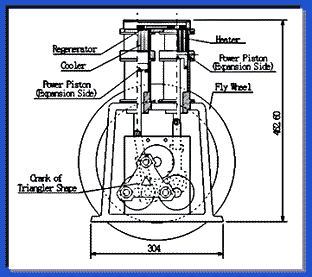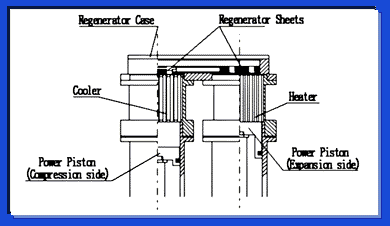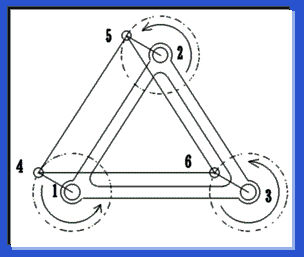
Structure of vertical 2 piston Stirling engine
 Japanese
Japanese
 The vertical 2 piston Stirling engine is alpha type Stirling engine produced for experiment as the engine of comparative small output. Cylinders on both of expansion side and compression side are arranged by erection on clankcasing, and a heater and cooler are arranged by upper part of each cylinder. Expansion space and compression space formed by these components are connected by a regenerator case and become very compact layout. The bore and stroke of pistons are both 50 mm, and these pistons are connected cranks refered cross heads. Both crank shaft and output shaft are connected by a clank of a triangular shape that is unique mechanism. The crank case of this engine is able to use as buffer space. In each power piston 1-way piston ring is used, then minimum pressure in engine increase to close buffer pressure, and be able to make output of an engine improve.
The vertical 2 piston Stirling engine is alpha type Stirling engine produced for experiment as the engine of comparative small output. Cylinders on both of expansion side and compression side are arranged by erection on clankcasing, and a heater and cooler are arranged by upper part of each cylinder. Expansion space and compression space formed by these components are connected by a regenerator case and become very compact layout. The bore and stroke of pistons are both 50 mm, and these pistons are connected cranks refered cross heads. Both crank shaft and output shaft are connected by a clank of a triangular shape that is unique mechanism. The crank case of this engine is able to use as buffer space. In each power piston 1-way piston ring is used, then minimum pressure in engine increase to close buffer pressure, and be able to make output of an engine improve.
Engine Specifications
| Engine type | Alfa type |
|---|
| Power piston of Expansion Side | Bore | 50mm |
|---|
| Stroke | 50mm |
| Swept Volme | 98.17cc |
| Power piston of Compression Side | Bore | 50mm |
|---|
| Stroke | 50mm |
| Swept Volme | 98.17cc |
| Drive Mechanism | Three Parallel Crank and Coupling Rods |
|---|
| Phase Angle | 90degree |
|---|
| height | 462.6mm |
|---|
| weight | 30kg |
|---|

 Characteristics and structure of heat exchangers
Characteristics and structure of heat exchangers
A heat exchanger is arranged by a gate form by a heater, regenerator, cooler. For the heater, The form is choosen that Block Bored Meny Holes insert to the shell of stainless steel made, considering erectric heat wire heating. For the cooler, shell and tubes type is adopted, and working gas pass through pipe inside, and outside of pipe, cooling water pass. The regenerator adopt a form to pile up many nets of stainless steel made.
Heat Exchanger Specifications
| Heater | Volume | 16.96cm3 |
|---|
| Type | Block Bored Many Holes |
| Material | Copper |
| Number of Holes | 108 |
| Diameter of Holes/td> | 2mm |
| Length of Holes | 50mm |
| Cooler | Volume | 34.97cc |
|---|
| Type | Shell and Tubes |
| Material | Copper |
| Number of Tubes | 97 |
| Inner Diameter of Tubes | 3mm |
| Length of Tubes | 51mm |
| Regenerator | Type | Wire Sheets Laminated |
|---|
| Material | Stainless Steel Wire Cloth |
| Mesh | 60 |
| Number of Sheets | 276 |

 The driven Mechanism
The driven Mechanism
A driving mechanism of the engine is the shape to join three parallel clanks like a figure. At this figure, the length of crank 14, 25 and 36 are equal. And length of Connecting rod 45, 56 and 64 are mutually equal to distance of crank shaft 12, 23, 31. Therefore the motion of crank 1 is linked up with crank2 and crank 3 as the rotatory motion with no dead point. For this mechanism, a loss of a mechanism itself is very little, and by adopting this mechanism, it is able that the size of engine include Fry wheel makes to very compact becouse the output shaft is located center of the engine.
 The performance of vertical 2 Piston Stirling Engine
The performance of vertical 2 Piston Stirling Engine
 Vertical 2 Piston Stirling Engine [NSE]
Vertical 2 Piston Stirling Engine [NSE]
 Return to Stirling Engines of Saitama University
Return to Stirling Engines of Saitama University
 Return to Stirling Engiene Home Page Academic Edition
Return to Stirling Engiene Home Page Academic Edition
 The vertical 2 piston Stirling engine is alpha type Stirling engine produced for experiment as the engine of comparative small output. Cylinders on both of expansion side and compression side are arranged by erection on clankcasing, and a heater and cooler are arranged by upper part of each cylinder. Expansion space and compression space formed by these components are connected by a regenerator case and become very compact layout. The bore and stroke of pistons are both 50 mm, and these pistons are connected cranks refered cross heads. Both crank shaft and output shaft are connected by a clank of a triangular shape that is unique mechanism. The crank case of this engine is able to use as buffer space. In each power piston 1-way piston ring is used, then minimum pressure in engine increase to close buffer pressure, and be able to make output of an engine improve.
The vertical 2 piston Stirling engine is alpha type Stirling engine produced for experiment as the engine of comparative small output. Cylinders on both of expansion side and compression side are arranged by erection on clankcasing, and a heater and cooler are arranged by upper part of each cylinder. Expansion space and compression space formed by these components are connected by a regenerator case and become very compact layout. The bore and stroke of pistons are both 50 mm, and these pistons are connected cranks refered cross heads. Both crank shaft and output shaft are connected by a clank of a triangular shape that is unique mechanism. The crank case of this engine is able to use as buffer space. In each power piston 1-way piston ring is used, then minimum pressure in engine increase to close buffer pressure, and be able to make output of an engine improve.
 Japanese
Japanese
 Characteristics and structure of heat exchangers
Characteristics and structure of heat exchangers
 The performance of vertical 2 Piston Stirling Engine
The performance of vertical 2 Piston Stirling Engine Vertical 2 Piston Stirling Engine [NSE]
Vertical 2 Piston Stirling Engine [NSE] Return to Stirling Engines of Saitama University
Return to Stirling Engines of Saitama University Return to Stirling Engiene Home Page Academic Edition
Return to Stirling Engiene Home Page Academic Edition